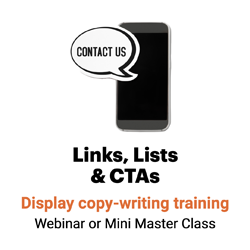Keep readers reading, skimmers scanning
The other day, I found a blog post of interest to me: “Maximizing student productivity: Tips for successful internship programs.”

My intern was scheduled to arrive in three minutes, so I quickly skimmed the story. I read the subheads: “Tip No. 1,” they said. “Tip No. 2. Tip No. 3.”
What were the tips? I’ll never know. Because the writer didn’t make the most of the powerful tools that are subheads.
Subheads have magical properties.
What if I told you there was a magic wand that kept readers reading and skimmers scanning — even after their attention begins to wane?
Friends, there is such a tool, and it’s called a subhead.
“Write subheads that reveal, rather than conceal, your contents.”
— Ann Wylie, writing coach, Wylie Communications
Great subheadings are mini headlines that grab reader attention and help skimmers get the gist of the message.
But label subheads — those that classify the topic but don’t say anything about it — don’t communicate much at all.
So instead of just labeling a section of your copy with the topic — “Mortgage services,” for instance, or “Tip. No. 1” — tell the reader something.
What about mortgage services? What is Tip No. 1?
To get the word out via subheads:
1. Make thinking visual.
Think of your subheads as the Roman numeral outline of your piece. What are your topics I, II and III? Those are your subheads.
So organize your message into a series of sections and subsections. Label the sections with subheads (“Make thinking visual,” in this story, for instance), the subsections with bullets or bold-faced lead-ins (“Acknowledge the event,” on this page).
When one of my clients wanted to lend support after some of its employees endured a fire, subheads included:
- Acknowledge the event.
- Listen. Don’t ask questions or seek details.
- Offer long-term emotional support.
- Offer practical support.
- Watch for reactions.
Any questions?
Write subheads that reveal, rather than conceal, your contents.
2. Don’t write ‘read below’ subheads.
If your subheads say “Problem,” “Solution” and “Result,” you’re telling readers, “read below to find out what the problem, solution and results are.”
But they’re not reading. They’re skimming!
Instead of trying to force skimmers to read, write robust subheads that define the problem, solution and results. Concisely describe the content within each section in a subhead. Use simple, understandable words. Test: Could your grandma understand it?
3. Answer, don’t just ask, questions.
If you raise a question in the subhead, answer it in display copy — a bold-faced lead-in, highlighted key words or a bulleted list, maybe.
If your subhead asks, “Why subheads?” for instance, you might answer the question in a list with bold-faced lead-ins:
- Keep readers reading.
- Communicate to nonreaders.
- Draw readers in.
- Break copy up.
- Make messages memorable.
Otherwise, your question is essentially saying “read below to find out.” And we know skimmers want to skim, not read.
Bottom line: If you ask a question in the display copy, you need to answer the question in the display copy.
4. Set up the next section.
Don’t summarize what you’ve already covered, but preview the best of what is to come.
5. Don’t repeat other microcontent.
Avoid using the same words and phrases you’re using in headlines, captions and callouts. Your subheadings help you get the word out to flippers and skimmers. This is San Francisco real estate: Don’t say the same thing twice.
6. Make them compelling.
Write compelling subheads. Choose your words carefully. Craft subheads using intriguing phrases, interesting words.
7. Use subheads frequently.
Use at least one on a short (10- to 12-paragraph) story, recommend the folks at the BBC News Academy. Longer story? Include a subhead every four to six paragraphs.
Note that you’ll have a subhead for each topic in the body of your story, plus one subhead to separate the body from the conclusion (for this story: Don’t drop the subheads.) So if you have three topics, you’ll have four subheads.
8. Keep them short.
Limit subheads to one line — on your phone. (Tip: Email your message to yourself and check it on your mobile to make sure.) That probably means up to five words.
Longer, and they’ll start looking like text, not display copy. And then you’ll lose the attention-grabbing power of subheads.
9. Grab the eye.
“Subheads only get looked at if they actually look like subheads,” write Pernice, et al. “If the sections and their subheads are not different enough, then people will not be able to use them as the lighthouses they are meant to be.”
So once you’ve written subheads, make them eye-catching with larger text, bold-faced type, color, more white space. Make sure there’s plenty of contrast between the text and background, and avoid putting an image behind the text.
But don’t make them distracting.
It’s the Goldilocks rule: Use just enough to set them apart from plain text. Use too much formatting, and they’ll distract skimmers from the rest of the page. Use too little formatting, and skimmers won’t look at them.
Don’t drop the subheads.
Online, writing subheads “may be the most important thing you do” to get readers to read and help skimmers skim. So don’t drop the subheads.
___
Sources: “Writing for mobile: Bite-size basics,” BBC Academy, Dec. 2, 2014
Kara Pernice, Kathryn Whitenton and Jakob Nielsen; How People Read on the Web: The Eyetracking Evidence; Nielsen Norman Group; Sept. 10, 2013

Leave a Reply